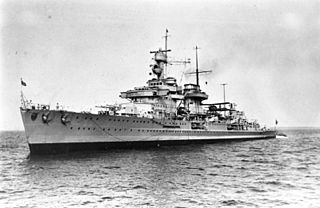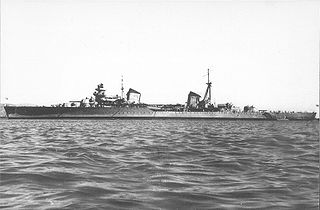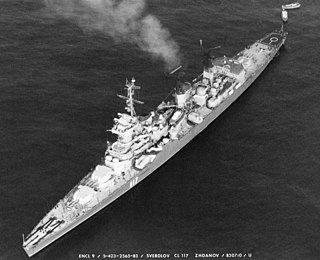
The Kirov-class cruisers were a class of six cruisers built in the late 1930s for the Soviet Navy. After the first two ships, armor protection was increased and subsequent ships are sometimes called the Maxim Gorky class. These were the first large ships built by the Soviets from the keel up after the Russian Civil War, and they were derived from the Italian cruiser Raimondo Montecuccoli, being designed with assistance from the Italian Ansaldo company. Two ships each were deployed in the Black and Baltic Seas during World War II, while the last pair was still under construction in the Russian Far East and saw no combat during the war. The first four ships bombarded Axis troops and facilities after the Germans invaded the Soviet Union in June 1941. All six ships survived the war and lingered in training and other secondary roles, with three being scrapped in the early 1960s and the other three a decade later.

The Leipzig class was a class of two light cruisers of the German Reichsmarine and later Kriegsmarine; the class comprised Leipzig, the lead ship, and Nürnberg, which was built to a slightly modified design. The ships were improvements over the preceding Königsberg-class cruisers, being slightly larger, with a more efficient arrangement of the main battery and improved armor protection. Leipzig was built between 1928 and 1931, and Nürnberg followed between 1934 and 1935.

The Sverdlov-class cruisers, Soviet designation Project 68bis, were the last conventional gun cruisers built for the Soviet Navy. They were built in the 1950s and were based on Soviet, German, and Italian designs and concepts developed prior to the Second World War. They were modified to improve their sea capabilities, allowing them to run at high speed in the rough waters of the North Atlantic. The basic hull was more modern and had better armor protection than the vast majority of post-World War II gun cruiser designs built and deployed by peer nations. They also carried an extensive suite of modern radar equipment and anti-aircraft artillery. The Soviets originally planned to build 40 ships in the class, to be supported by the Stalingrad-class battlecruisers and aircraft carriers.

The Stalingrad-class battlecruiser, also known as Project 82, was a Soviet battlecruiser design from 1941. It was a smaller and less-expensive counterpart to the Kronshtadt-class battlecruisers of 1939. The original role was for a light, fast ship intended to break up attacks by British fast-cruiser forces that might attempt bombardment of Russia's northern ports. In keeping with the battlecruiser design concept, they would have been able to outgun any ship with similar speed, or outrun anything more heavily armed. Design work had just started when the German invasion of the Soviet Union opened and the design was put on hold.
Kalinin (Калинин) was one of six Kirov-class cruisers built for the Soviet Navy in the Russian Far East from components shipped from European Russia during World War II. The ship was one of the last pair constructed, known as the Project 26bis2 subclass. Completed at the end of 1942 and assigned to the Pacific Fleet, she saw no action during the Soviet–Japanese War in 1945 and served into the Cold War. Sometimes serving as a flagship, her post-war career was uneventful until she was disarmed and converted into a floating barracks in 1960. She was scrapped in the early 1960s.

Kirov was a Project 26 Kirov-class cruiser of the Soviet Navy that served during the Winter War and World War II, and into the Cold War. She attempted to bombard Finnish coast defense guns during action in the Winter War, but was driven off by a number of near misses that damaged her. She led the Evacuation of Tallinn at the end of August 1941, before being blockaded in Leningrad where she could only provide gunfire support during the siege of Leningrad. She bombarded Finnish positions during the Vyborg–Petrozavodsk Offensive in mid-1944, but played no further part in the war. Kirov was reclassified as a training cruiser on 2 August 1961 and sold for scrap on 22 February 1974.

Murmansk was a light cruiser project no. 68-bis of the Soviet and later the Russian Navy's Northern Fleet.

Molotov was a Project 26bis Kirov-class cruiser of the Soviet Navy that served during World War II and into the Cold War. She supported Soviet troops during the Siege of Sevastopol, the Kerch-Feodosiya Operation and the amphibious landings at Novorossiysk at the end of January 1943.

Mikhail Kutuzov is a light cruiser project no. 68-bis of the Soviet and later the Russian Navy's Black Sea Fleet.

RI Irian (201), previously named Ordzhonikidze was a Sverdlov-class cruiser, Soviet designation "Project 68bis", of the Soviet Navy that was acquired by Indonesian Navy in the 1960s.

Sverdlov was the lead ship of the Sverdlov-class cruisers of the Soviet Navy. The ship was constructed at the Baltic Shipyard in Leningrad, Soviet Union and was launched on 5 July 1950. The cruiser was commissioned on 15 May 1952. The lead ship of the last class of gun cruisers of the Soviet Navy, Sverdlov spent most of her career making ceremonial port visits to allied and non-allied nations. From 1966 to 1972, the vessel was laid up out of service, only operating again before being laid up again in 1977. In 1989 the ship was disarmed and sold for scrap to an Indian company and broken up in 1993.

Zhdanov was a Sverdlov-class cruiser of Soviet Navy.

Aleksandr Suvorov was a Sverdlov-class cruiser of Soviet Navy.
Admiral Senyavin was a Sverdlov-class cruiser of the Soviet Navy.

Dmitry Pozharsky was a Sverdlov-class cruiser of the Soviet Navy.

Aleksandr Nevsky was a Sverdlov-class cruiser of the Soviet Navy.

Admiral Lazarev was a Sverdlov-class cruiser of the Soviet Navy.

Dzerzhinsky was a Sverdlov-class cruiser of the Soviet Navy.
Admiral Nakhimov was a Sverdlov-class cruiser of the Soviet Navy.

Molotovsk was a Sverdlov-class cruiser of the Soviet Navy which was later renamed Oktyabrskaya Revolutsiya.
















